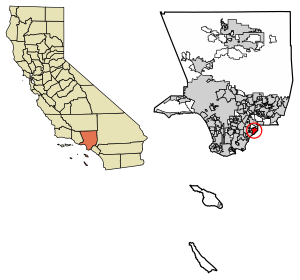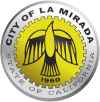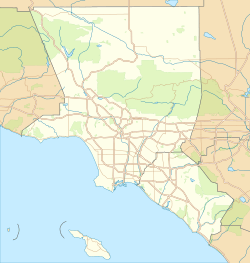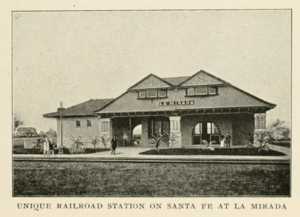La Mirada, California facts for kids
Quick facts for kids
La Mirada, California
|
|||
|---|---|---|---|
|
|||
| Motto(s):
Dedicated to Service
|
|||

Location of La Mirada in Los Angeles County, California
|
|||
| Country | |||
| State | |||
| County | Los Angeles | ||
| Incorporated | March 23, 1960 | ||
| Government | |||
| • Type | Council–Manager | ||
| Area | |||
| • Total | 7.84 sq mi (20.30 km2) | ||
| • Land | 7.82 sq mi (20.26 km2) | ||
| • Water | 0.02 sq mi (0.04 km2) 0.22% | ||
| Elevation | 194 ft (59 m) | ||
| Population
(2020)
|
|||
| • Total | 48,008 | ||
| • Density | 6,159.93/sq mi (2,378.23/km2) | ||
| Time zone | UTC-8 (Pacific) | ||
| • Summer (DST) | UTC-7 (PDT) | ||
| ZIP codes |
90637–90639
|
||
| Area code | 562, 657/714 | ||
| FIPS code | 06-40032 | ||
| GNIS feature IDs | 1652736, 2411577 | ||
La Mirada is a city located in the southeast part of Los Angeles County, California, United States. It is one of the Gateway Cities, which are a group of cities in southeast Los Angeles County. La Mirada is also right on the border with Orange County.
In 2020, the city had a population of 48,008 people. La Mirada is known for its fun attractions like the La Mirada Theatre for the Performing Arts and the Splash! La Mirada Regional Aquatics Center. It is also home to Biola University, a private Christian college.
Contents
History of La Mirada
The name "La Mirada" means "the look" in Spanish. This city was first created by two men: Andrew McNally and his son-in-law, Edwin Neff. McNally was a printer and mapmaker from Chicago, famous for Rand McNally maps.
Early Development and Farming
In 1888, McNally bought over 2,200 acres (about 9 square kilometers) of land from a large ranch called Rancho Los Coyotes. He paid $200,000 for this land, which was south of Whittier.
McNally developed 700 acres (about 2.8 square kilometers) into his own home, which he called Windermere Ranch. He planted many olive, orange, and lemon trees around his home. He even built a factory to process olive oil, which was known for being very good quality. McNally also built a train station to ship his olive oil and fruit across the U.S.
The La Mirada Land Company
In 1896, McNally gave his property to his daughter and son-in-law. They then started the La Mirada Land Company. This company created a booklet called "The Country Gentleman in California." The booklet advertised land for sale with pictures, a map, and descriptions of the beautiful olive, alfalfa, lemon, and grapefruit groves.
By 1946, La Mirada was a small community with only 213 people. It was surrounded by farms, oil wells, an olive oil factory, and fruit packing houses.
Becoming a Planned City
In the early 1950s, La Mirada became famous for being a "completely planned city." The California State Fair praised the city for thinking about the future while still being practical for the present.
In 1953, the land was sold for $5.2 million, which was one of the biggest land deals in California at the time. A year later, in 1954, a builder named Louis M. Halper bought 2,100 acres of La Mirada land for $8 million.
Halper started building a huge community worth $150 million. He planned to build schools, shopping centers, and 10,000 homes. He finished these homes within two years. Halper also created the La Mirada Civic Council to make sure the quality of the new community stayed high.
City Incorporation and Growth
Homes with three or four bedrooms were sold for around $13,000. By 1960, the year the city officially became a city, La Mirada had grown from just 100 homes to over 8,000.
The city was first named "Mirada Hills" when it became incorporated on March 23, 1960. However, on November 8, 1960, voters decided to change the name to La Mirada. This change became official on December 15, 1960. Today, La Mirada has a population of over 50,000 people.
Geography and Location
La Mirada covers a total area of about 7.9 square miles (20.3 square kilometers). Most of this area, about 7.8 square miles (20.26 square kilometers), is land. Only a small part, about 0.02 square miles (0.04 square kilometers), is water.
The city is located right on the border between Orange County and Los Angeles County.
- Los Angeles County Neighbors: To the west, La Mirada borders Santa Fe Springs. To the southwest, it borders Cerritos. North of La Mirada are unincorporated areas of Los Angeles County like East Whittier and South Whittier.
- Orange County Neighbors: To the east, La Mirada borders Fullerton and La Habra. To the south, it borders Buena Park.
Population and People
| Historical population | |||
|---|---|---|---|
| Census | Pop. | %± | |
| 1960 | 22,444 | — | |
| 1970 | 30,808 | 37.3% | |
| 1980 | 40,986 | 33.0% | |
| 1990 | 40,452 | −1.3% | |
| 2000 | 46,783 | 15.7% | |
| 2010 | 48,527 | 3.7% | |
| 2020 | 48,008 | −1.1% | |
| U.S. Decennial Census | |||
La Mirada has grown quite a bit since it became a city. In 1960, the population was around 22,444 people. By 2020, it had grown to 48,008 people.
Population in 2010
According to the 2010 United States Census, La Mirada had 48,527 residents. The city is quite diverse. About 60.7% of the people were White, 17.8% were Asian, and 2.3% were African American. About 39.7% of the population identified as Hispanic or Latino.
Most people in La Mirada, about 94.1%, lived in regular homes. The average household had about 3.11 people. Many families lived in the city, with the average family size being 3.48 people.
The population was spread out across different age groups. About 21.1% of residents were under 18 years old, and 15.2% were 65 years or older. The average age in La Mirada was 37.9 years.
Most homes in La Mirada were owned by the people living in them, about 79.1%. The remaining 20.9% were rented.
Population in 2000
In the year 2000, La Mirada had 46,783 people. The racial makeup was similar to 2010, with 64.46% White, 14.88% Asian, and 1.93% Black or African American. About 33.47% of the population was Hispanic or Latino.
The median income for a household in La Mirada in 2000 was $61,632. This means half of the households earned more than this amount, and half earned less.
Education in La Mirada
La Mirada offers several options for education, from public schools to private colleges.
Public Schools
Most public schools in La Mirada are part of the Norwalk-La Mirada Unified School District. This school district has its main office in nearby Norwalk. La Mirada has one public high school, La Mirada High School.
Some neighborhoods in northern La Mirada, like Creek Park and Granada Heights, are part of different school districts. These include the East Whittier City School District for K-8th grades and the Whittier Union High School District for high school. These districts have campuses in Whittier.
Private Schools
There are also several private schools in La Mirada:
- St. Paul of the Cross School (in the Foster Park neighborhood)
- Beatitudes of Our Lord School
Higher Education
La Mirada is home to one private college, Biola University. This university offers many different study programs.
Many people in La Mirada have gone to college. About 26.23% of the population has some college education, and 20.08% have a Bachelor's degree.
Transportation in La Mirada
Getting around La Mirada and to other cities is easy with various transportation options.
Train and Bus Services
Metrolink provides train service for people who commute (travel to work or school). The closest Metrolink stations to La Mirada are Buena Park and Norwalk/Santa Fe Springs.
Public bus transportation is available through several services:
- Los Angeles County Metropolitan Transportation Authority (Metro)
- Norwalk Transit
- Montebello Bus Lines
The LA Metro Route 460 bus can take you to downtown Los Angeles and the Crypto.com Arena.
Main Roads
Several main roads run through La Mirada, making it easy to drive around.
- West-to-East Roads: These include Rosecrans Avenue, Alondra Boulevard, and Imperial Highway.
- South-to-North Roads: These include Valley View Avenue, La Mirada Boulevard, and Santa Gertrudes Avenue.
- Other important roads are Leffingwell Road (on the north side) and Artesia Boulevard (on the south side).
- Interstate 5 briefly passes through the southwest part of the city. Beach Boulevard (SR 39) also passes through the east end of the city.
Freight Trains
Freight trains, which carry goods, also pass through La Mirada. The BNSF Railway operates trains in the southwest part of the city. The Union Pacific Railroad also has a rail line near Interstate 5, serving industrial areas.
Economy and Jobs
La Mirada has a strong local economy with various businesses and employers. The local newspaper, Los Cerritos Community News, is based in the city.
Top Employers in La Mirada
Here are some of the largest employers in La Mirada, based on information from 2017:
| # | Employer | Number of Employees |
|---|---|---|
| 1 | Biola University | 1,365 |
| 2 | Norwalk-La Mirada Unified School District | 843 |
| 3 | US Food Service | 650 |
| 4 | Kindred Hospital La Mirada | 266 |
| 5 | City of La Mirada | 306 |
Notable People from La Mirada
Many interesting people have connections to La Mirada, including athletes, actors, and musicians:
- Gary Allan, country singer
- Jacob Barron, soccer player
- Derby Carillo, Salvadoran soccer player
- Tony Corrente, NFL referee
- Chase De Leo, professional ice hockey player
- Jennie Finch, Olympic softball player
- Steven L. Kwast, Air Force lieutenant general
- Cole McDonald, football player
- Keith McGill, football player
- Shotaro Omori, American figure skater
- Daniel Poncedeleon, Major League Baseball pitcher
- Amber Riley, actress and singer (known for Glee)
- Ryan Vargas, NASCAR driver
- Derrick Williams, basketball player
- Eric Winter, actor (known for Days of Our Lives)
- YTCracker, former hacker and rapper
See also
 In Spanish: La Mirada para niños
In Spanish: La Mirada para niños







